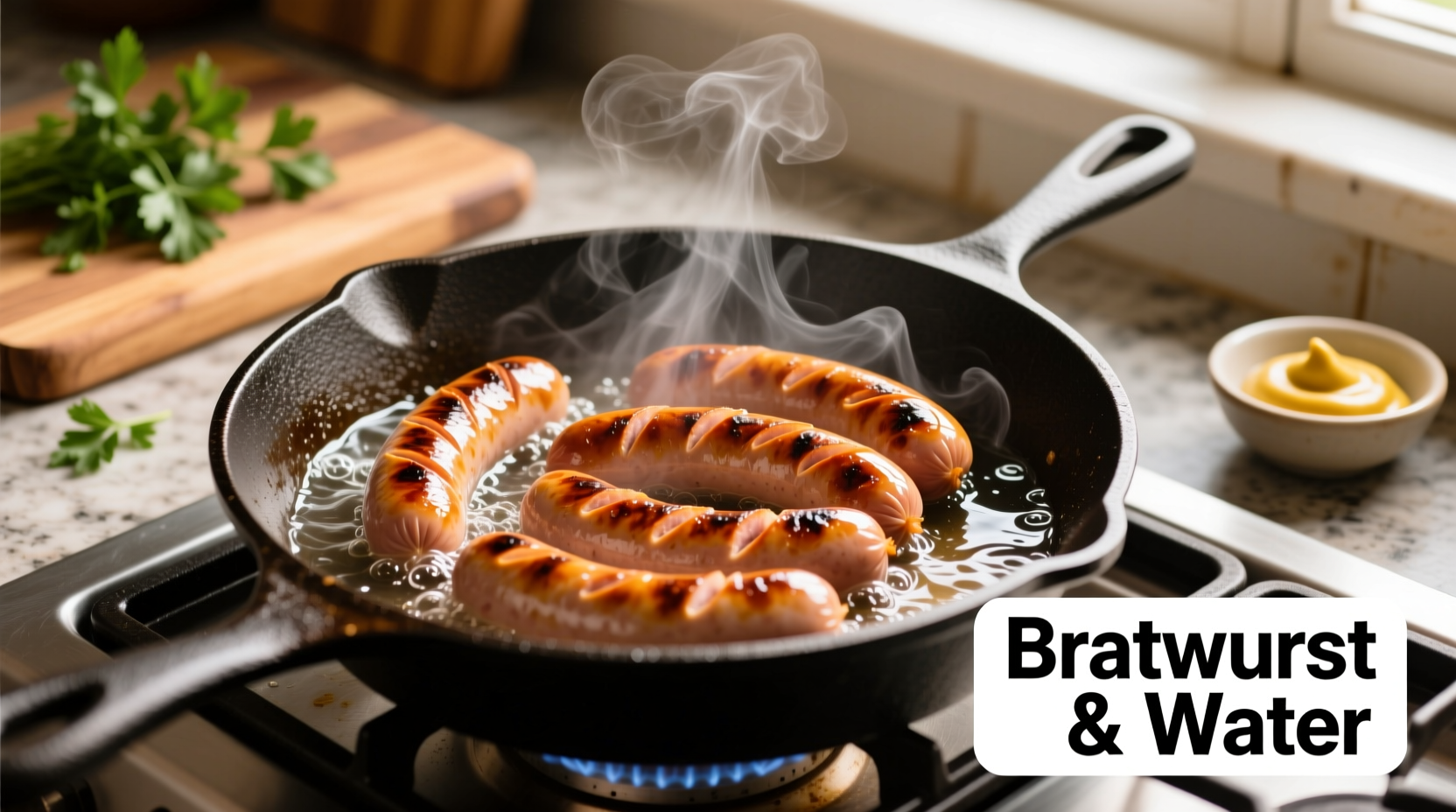Perfectly cook brats in a pan with water in 20 minutes: Place brats in cold skillet, add 1/2 inch water, cover and simmer 12-15 minutes until internal temperature reaches 160°F. Remove lid, increase heat to medium-high, and brown for 3-5 minutes, turning occasionally. Rest 5 minutes before serving.
Cooking bratwurst in a pan with water is the foolproof method for achieving juicy, evenly cooked sausages without splitting the casing. This technique, favored by professional chefs and home cooks alike, solves the common problem of dry or burst brats by gently poaching them before developing that essential caramelized exterior. In this guide, you'll learn the exact water-to-brat ratio, optimal cooking times, and professional tips that transform this German classic into a restaurant-quality meal.
Why Water Makes All the Difference
Adding water to your pan when cooking brats serves three critical purposes. First, it creates steam that gently cooks the interior without drying out the meat. Second, it prevents the casing from splitting by maintaining consistent temperature. Third, it allows the brats to reach safe internal temperature before browning, eliminating the risk of undercooked sausage. This method works particularly well for fresh, uncooked bratwurst that hasn't been pre-boiled.

What You'll Need
- 4 fresh bratwurst (about 1 pound)
- 1/2 inch water (enough to cover bottom of pan)
- 1 tablespoon cooking oil (for browning stage)
- Medium-sized skillet with lid
- Meat thermometer (essential for food safety)
- Tongs for handling
Step-by-Step Cooking Process
Preparation Stage
Remove brats from packaging and pat dry with paper towels. This crucial step ensures proper browning later. If your brats have packaging clips, carefully remove them. Place the cold skillet on your stove before adding the brats and water—starting with a cold pan prevents temperature shock that can cause casings to burst.
Cooking with Water
Place brats in the cold skillet in a single layer without overlapping. Add just enough water to cover the bottom of the pan (about 1/2 inch). Cover the skillet with a lid and turn heat to medium. After 2-3 minutes, the water will begin to simmer. Continue simmering covered for 12-15 minutes, turning brats occasionally with tongs. The water should maintain a gentle simmer throughout this stage—not a rolling boil.
| Cooking Method | Internal Temp Reached | Casing Integrity | Flavor Development |
|---|---|---|---|
| Water Method | 160°F evenly | Intact, no splitting | Balanced seasoning |
| Dry Pan Only | Inconsistent | Often splits | Overcooked exterior |
| Boiling First | 160°F | Intact | Seasoning leached out |
Temperature Timeline for Perfect Brats
Understanding the temperature progression ensures food safety while maintaining juiciness. According to USDA food safety guidelines, pork products must reach 160°F internally. With the water method, brats typically follow this progression:
- 0-5 minutes: Water heats to simmering point (180-200°F)
- 5-10 minutes: Brat interior reaches 120-140°F (safe but not fully cooked)
- 10-15 minutes: Brat interior reaches target 160°F (safe to eat)
- 15-20 minutes: Browning stage develops Maillard reaction (300°F+)
Always verify with a meat thermometer inserted horizontally through the side of the brat. The National Pork Board confirms that properly cooked bratwurst should register 160°F with clear juices.
Browning Stage
Once brats reach 160°F internally, remove the lid and increase heat to medium-high. Carefully pour out remaining water and add 1 tablespoon of cooking oil to the pan. Continue cooking uncovered for 3-5 minutes, turning frequently with tongs until evenly browned on all sides. This final stage develops complex flavor compounds through the Maillard reaction while rendering excess fat.
Resting and Serving
Transfer cooked brats to a plate and let rest for 5 minutes before serving. This allows juices to redistribute throughout the sausage. During this time, the internal temperature will rise slightly to 165°F, then stabilize as the meat relaxes. Serve on toasted buns with traditional toppings like sauerkraut, mustard, or caramelized onions.
When This Method Works Best
The water method shines with fresh, uncooked bratwurst that hasn't been pre-cooked. It's particularly effective for:
- Homemade bratwurst with natural casings
- High-fat content brats (25-30% fat)
- Cold weather cooking when outdoor grilling isn't practical
- Kitchen setups with limited ventilation
This technique isn't recommended for pre-cooked brats, which only need browning, or for very lean brat varieties that benefit from additional moisture during cooking. The water method also works best in cast iron or stainless steel skillets that distribute heat evenly—non-stick pans may not develop as good a sear.
Troubleshooting Common Issues
Problem: Brats are splitting during cooking
Solution: Reduce heat slightly and ensure water is simmering, not boiling vigorously. Never prick brats with a fork, as this releases juices.
Problem: Brats aren't browning well in final stage
Solution: Make sure the pan is sufficiently hot before adding oil. Pat brats dry with paper towel before the browning stage.
Problem: Brats are dry despite following instructions
Solution: Check internal temperature—overcooking past 165°F causes dryness. Consider using brats with higher fat content next time.
Serving Suggestions
Pair your perfectly cooked brats with traditional German sides for an authentic experience. Sauerkraut simmered with caraway seeds and apple slices complements the rich sausage flavor. Mustard varieties from mild yellow to spicy brown offer different flavor profiles—German-style stone-ground mustard provides the most authentic pairing. For a complete meal, serve with potato pancakes or German potato salad. The water cooking method preserves the brat's natural juices, making them ideal for pairing with crisp lager beers that cut through the richness.











 浙公网安备
33010002000092号
浙公网安备
33010002000092号 浙B2-20120091-4
浙B2-20120091-4